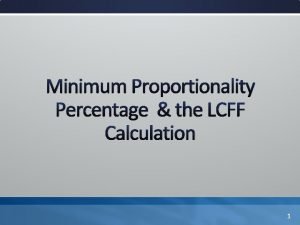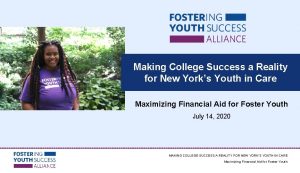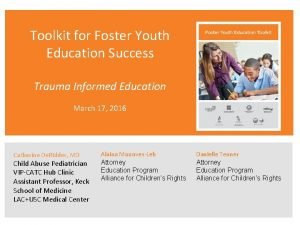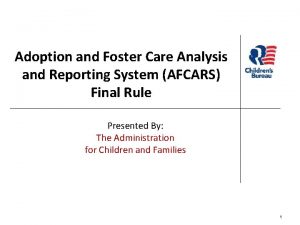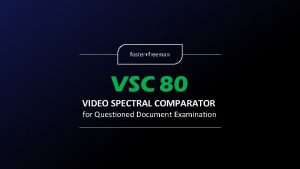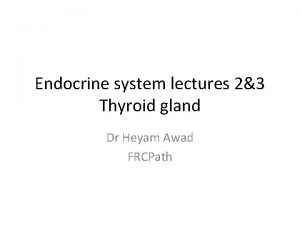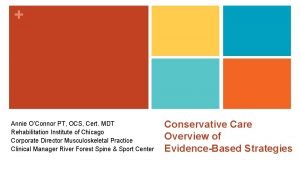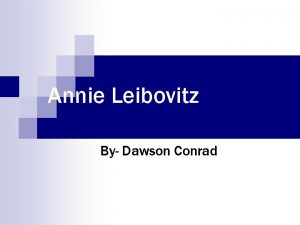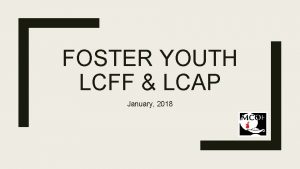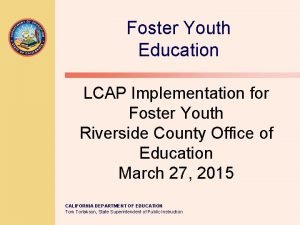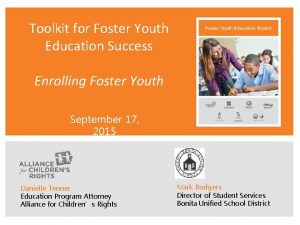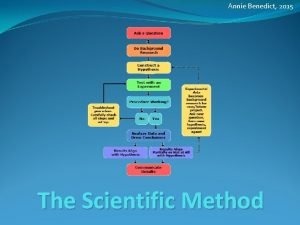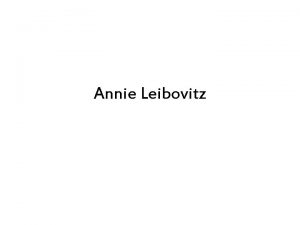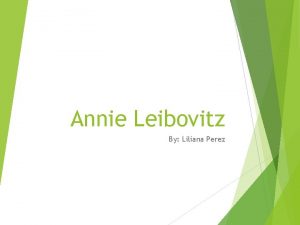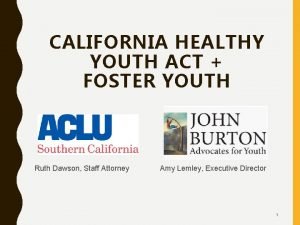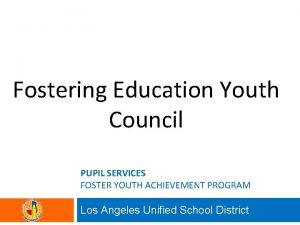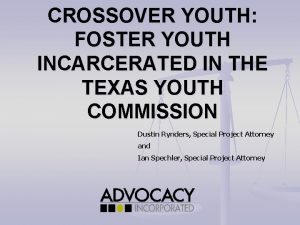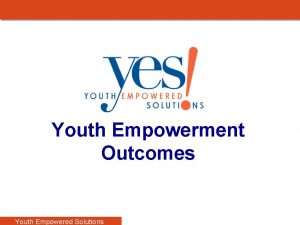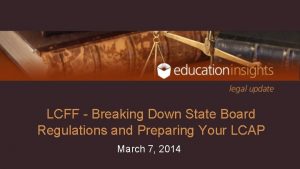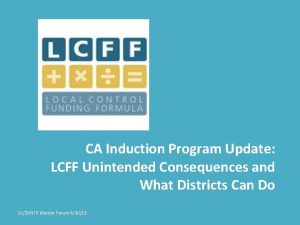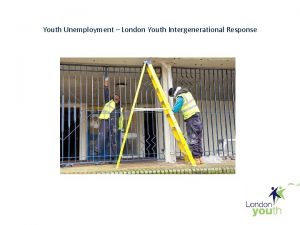LCFF and Its Impact on Foster Youth Annie































- Slides: 31

LCFF and Its Impact on Foster Youth Annie Lee Equal Justice Works Fellow, Foster. Ed National Center for Youth Law MAY 14, 2015 1

Background • Foster youth are children for whom the State has assumed responsibility for due to the presence or risk of neglect or abuse. • Of students in foster care, 43% are Hispanic, 26% are African-American, 23% are white, and 2% are Asian. 1 • LCFF recognizes foster youth as a distinct student subgroup because their educational outcomes are significantly worse than other at-risk populations of students. 1 West Ed, Invisible Achievement Gap (2013). 2

Invisible Achievement Gap According to West. Ed’s 2013 report, The Invisible Achievement Gap, California foster youth: Are significantly more likely to change schools; one-third of students in foster care change schools at least once during the school year See D’Anthony’s journey 3

Invisible Achievement Gap According to West. Ed’s 2013 report, The Invisible Achievement Gap, California foster youth: Test below basic and far below basic at twice the rate of students statewide and at significantly higher rates than low SES students Are significantly more likely to drop out than any other at-risk student group Have a 58 percent graduation rate, the lowest among at-risk student groups and as compared to a graduation rate of 84 percent for students statewide 4

Invisible Achievement Gap Placement changes impact schooling No disenrollment from previous school district Transfer into new district at any time during the year Sending district fails to provide up-to-date records Enrollment challenges (special needs, A-G credits, etc. ) Additional placement insecurity Inter-agency communication challenges Effects of trauma on learning 5

Promising Interventions Trauma-Informed Practices: Instruction, services and policies that respond to the multiple traumas experienced by most foster youth Education Success Plans: Goals and objectives based on the student’s identified educational strengths and needs Education Teams: Interagency teams that monitor educational progress and ensure services are delivered in a coordinated fashion Instructional Services: Access to necessary supplemental education services and opportunities Educational Champions: Adults supporting a foster youth’s school success as would an actively involved parent 6

Promising Infrastructure Inter-Agency Information Sharing District Level Policies Information sharing policies Partial credit policies Inter-agency agreements, including joint school stability and enrollment policies District Level Trainings Foster Youth Education Liaisons / Counselors / School Social Workers Assess educational strengths and needs Develop and monitor education plans Connect foster youth to supplemental education services Facilitate education teams 7

Complementary CDE Endorsed Student Support Strategies Multi-Tiered System of Supports (MTSS) Positive Behavior Intervention Supports (PBIS) Interconnected Systems Framework (ISF) to support PBIS Trauma-Informed Practices 8

Brief Overview of LCFF 9

Local Control Funding Formula A new funding formula that will increase school funding and direct more resources to California’s highest-need students LCFF acknowledges that foster youth, English Learners, and low-income youth have greater needs and require more resources Requires districts develop a Local Control and Accountability Plans (LCAP) that establish annual goals for students, describe actions/services to achieve those goals, detail how funds will be spent See ACLU “LCFF Guide” at https: //www. aclusocal. org/issues/education/local-control-funding-formula/ 10

LCFF and 8 State Priorities 11

LCFF and Foster Youth LCFF definition of “foster youth” includes any child with an open dependency case, regardless of home placement Includes child placed with relatives and in family maintenance Foster Youth Services (FYS) definition of “foster youth” limited to youth in group homes, foster family agencies, courtspecified placements and youth in juvenile detention facilities FYS definition only captures about a third of LCFF foster youth Many youth not receiving supplemental supports Differing definitions causing confusion in districts 12

LCAPs and Foster Youth 13

Foster. Ed Analysis Preliminary findings based on: Analysis of the LCAPs of the 10 school districts that enroll the most foster youth. These districts account for a quarter of California’s foster youth. Statewide survey of county office of education foster youth services coordinators. Interviews with Superintendent; Assistant Superintendents; Director, Student Support Services; Director, Education Services; Director of Special Education Services; Coordinator of Student Services; Coordinator of Community Resources; and Foster Youth Services Coordinators. 14

Foster. Ed Analysis High variability in how districts plan to improve the educational outcomes of foster youth Relatively few districts plan to provide foster youth unique services or supports Relatively few district LCAPs include the interventions and infrastructure elements deemed most critical by the field to help foster youth Select districts have well-developed, promising plans for closing the foster youth achievement gap 15

Statewide Analysis of LCFF Year 1 Ed Trust-West’s December 2014 report, “The Local Control Funding Formula’s First Year”: Interviews with over 60 community and district leaders, detailed analysis of 40 LCAPs, shorter review of 100 LCAPs Variability in district consultation with stakeholders, including foster youth caregivers Most districts do not directly and distinctly address the needs of foster youth in their first-year LCAPs apart from saying they will receive the same services as all students Unclear how supplemental and concentration grants will increase or improve services for foster youth 16

Statewide Analysis of LCFF Year 1 SRI International and J. Koppich & Associates’ “Foster Youth and the Local Control Funding Formula: Not Yet Making the Grade” 6 districts, 6 county offices of education, 40 LCAPs Few examples of targeted service for foster youth Weak community engagement Year of awareness for districts and county offices of education Need to make foster youth visible Need for district-county collaboration and county inter-agency collaboration 17

Statewide Analysis of LCFF Year 1 Public Counsel’s “Fostering Educational Success: An Analysis of Investments in School Climate and Foster Youth Through the LCAP” 62 districts, 2 county offices of education, 64 LCAPs Few school districts identified attendance-related goals for foster youth Few school districts identified suspension goals and actions unique to foster youth Many districts expended the same or more on school law enforcement officers and equipment than on research-based, whole school strategies for creating a positive and supportive school climate 18

Examples of Promising LCAPs Los Angeles Unified School District (approx. 11, 000 foster youth) $9. 9 million to hire 75 foster youth counselors and foster youth specific school social workers responsible for identifying educational strengths and needs and monitoring educational progress All elementary foster youth will receive a comprehensive academic assessment; all secondary foster youth will have an individualized culmination or graduation plan; increase in tutoring services Poway Unified School District (approx. 50 foster youth) $44, 000 to develop and implement foster youth support protocols Train counselors and administrators in support processes for foster youth Administrator and counselor cultural and PBIS training 19

Improving District Plans District stakeholders consistently identified that the following would help them develop and implement improved plans for foster youth: Information on the most common educational challenges facing foster youth and how to better collaborate with county agencies Information, resources and tools specific to promising interventions Additional guidance and support from those familiar with promising interventions and necessary infrastructure Examples of promising district plans for improving foster youth outcomes 20

District & County Education Agencies Districts are best positioned to support foster youth in school and in the classroom By educating staff on trauma-informed practices and foster youth issues By establishing district policies and infrastructure necessary to ensure foster youth receive the educational opportunities they need to thrive in school By developing and monitoring education plans and facilitating education teams By providing supplemental education services County offices of education are best positioned to support school districts By increasing collaboration and information sharing across county agencies, including the child welfare, probation, mental health, and judicial agencies, as well as across districts By providing expertise on designing and implementing effective intervention systems for foster youth By ensuring every foster youth has an educational champion and education rights holder supporting their success in school as would an actively involved parent 21

LCFF Accountability: Evaluation Rubrics 22

LCFF: Accountability and Foster Youth Evaluation rubrics: LCFF requires SBE to develop and adopt evaluation rubrics by October 1, 2015. 2 Holistic, multidimensional assessment of School district and individual school site performance On all 8 state priorities Must provide standards on each state priority for district and school site Standard for performance Standard for improvement 23 2 Ed. Code Section 52064. 5

LCFF: Accountability and Foster Youth Purpose of rubrics: Assist districts in evaluating their strengths and weaknesses Used by COEs to determine if a school district does not improve outcomes in more than one state priority for at least one subgroup, and thus is required to receive support (COE review, academic expert, CA Collaborative for Educational Excellence) Used by SPI to determine if a district does not improve outcomes in three of four consecutive years for three or more subgroups in more than one state or local priority, and thus is considered to be persistently failing 24

LCFF: Accountability and Foster Youth Foster youth and the evaluation rubrics: Disaggregated data for foster youth in all 8 state priorities Support for foster youth educational improvement Review outcomes and actions/services for foster youth: How are foster youth doing overall? Are foster youth outcomes improving? Is the foster youth achievement gap closing? How can districts improve foster youth outcomes? Best practices, including promising interventions and infrastructure 25

LCFF: Accountability and Foster Youth Current iteration of the rubrics (note: this iteration will change after SBE feedback during the May 7, 2015 meeting) 26

CCEE and Foster Youth 27

LCFF: Accountability and Foster Youth California Collaborative for Educational Excellence (CCEE)3 5 person governing board and currently hiring staff, including executive director Will provide advice and assistance to LEAs (charter schools, school districts, and county offices of education) in achieving the goals set forth in LCAPs Technical assistance not limited to the following: 8 state priorities Improve the quality of teaching Improve the quality of school district and school site leadership Successfully address needs of special student populations, including English Learners, low-income youth, foster youth, and students with exceptional needs 28 3 Ed. Code Section 52074

Recommendations - State FYS program needs to be updated and aligned with LCFF statutes Evaluation rubrics should include foster youth specific metrics, set rigorous standards for improvement for foster youth, and disaggregate foster youth in data analysis and other portions of the rubrics SBE should receive biannual updates on LCFF’s impact on foster youth 29

Recommendations - Local LEAs should have increased access to tools and resources specific to: The most common educational challenges facing foster youth Promising infrastructure and interventions for foster youth LEAs should have increased access to expert assistance to help them develop and implement improved plans and programs for foster youth LCAPs should show supplemental and concentration funds will be spent on services that principally address the districts’ goals for foster youth and that are likely to be effective 30

Contact Information Annie Lee Equal Justice Works Fellow Foster. Ed: An Initiative of the National Center for Youth Law Phone: 510 -899 -6569 E-mail: alee@youthlaw. org 31
 Lcff calculator
Lcff calculator Foster youth college success initiative
Foster youth college success initiative Trauma informed care for foster youth
Trauma informed care for foster youth Define the term renaissance
Define the term renaissance Lesson 5 the slave trade and its impact on africa
Lesson 5 the slave trade and its impact on africa Adoption and foster care analysis and reporting system
Adoption and foster care analysis and reporting system Annie leibovitz romeo and juliet
Annie leibovitz romeo and juliet Parallel and non parallel structure
Parallel and non parallel structure The emigree analysis
The emigree analysis Its halloween its halloween the moon is full and bright
Its halloween its halloween the moon is full and bright Video spectral comparator (vsc)
Video spectral comparator (vsc) Foster and freeman vsc 80
Foster and freeman vsc 80 Foster and maintain business relationships
Foster and maintain business relationships Annie hudson bristol
Annie hudson bristol Annie prasad
Annie prasad Annie faure peintre
Annie faure peintre Annie faure peintre
Annie faure peintre Living like weasels summary
Living like weasels summary Annie chapman
Annie chapman Orphan annie eye nuclei
Orphan annie eye nuclei Et oui le temps passe
Et oui le temps passe Annie faure peintre
Annie faure peintre Annie leibovitz queen elizabeth
Annie leibovitz queen elizabeth Anne sullivan brother
Anne sullivan brother Annie stegg
Annie stegg Annie o'connor physical therapist
Annie o'connor physical therapist Annie leibovitz queen elizabeth
Annie leibovitz queen elizabeth Annie leibovitz influences
Annie leibovitz influences Annie gilbert
Annie gilbert Annie dubuisson
Annie dubuisson Annie beghin
Annie beghin Annie abrams little rock
Annie abrams little rock
